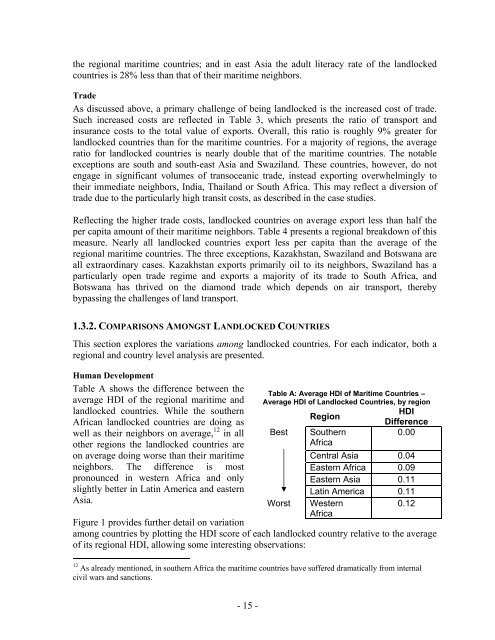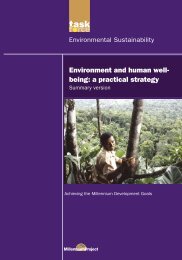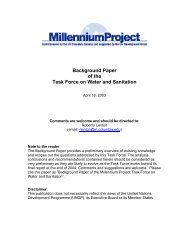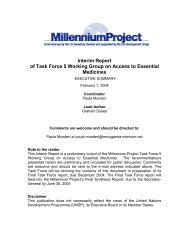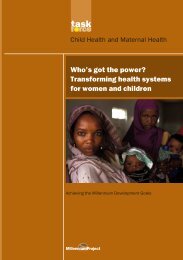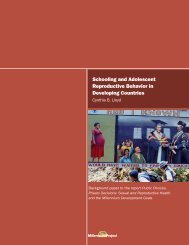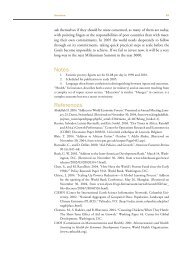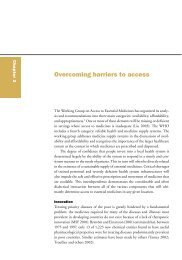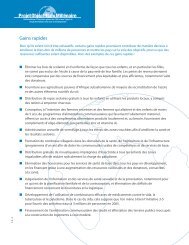the challenges facing landlocked developing countries: a case study ...
the challenges facing landlocked developing countries: a case study ...
the challenges facing landlocked developing countries: a case study ...
You also want an ePaper? Increase the reach of your titles
YUMPU automatically turns print PDFs into web optimized ePapers that Google loves.
<strong>the</strong> regional maritime <strong>countries</strong>; and in east Asia <strong>the</strong> adult literacy rate of <strong>the</strong> <strong>landlocked</strong><br />
<strong>countries</strong> is 28% less than that of <strong>the</strong>ir maritime neighbors.<br />
Trade<br />
As discussed above, a primary challenge of being <strong>landlocked</strong> is <strong>the</strong> increased cost of trade.<br />
Such increased costs are reflected in Table 3, which presents <strong>the</strong> ratio of transport and<br />
insurance costs to <strong>the</strong> total value of exports. Overall, this ratio is roughly 9% greater for<br />
<strong>landlocked</strong> <strong>countries</strong> than for <strong>the</strong> maritime <strong>countries</strong>. For a majority of regions, <strong>the</strong> average<br />
ratio for <strong>landlocked</strong> <strong>countries</strong> is nearly double that of <strong>the</strong> maritime <strong>countries</strong>. The notable<br />
exceptions are south and south-east Asia and Swaziland. These <strong>countries</strong>, however, do not<br />
engage in significant volumes of transoceanic trade, instead exporting overwhelmingly to<br />
<strong>the</strong>ir immediate neighbors, India, Thailand or South Africa. This may reflect a diversion of<br />
trade due to <strong>the</strong> particularly high transit costs, as described in <strong>the</strong> <strong>case</strong> studies.<br />
Reflecting <strong>the</strong> higher trade costs, <strong>landlocked</strong> <strong>countries</strong> on average export less than half <strong>the</strong><br />
per capita amount of <strong>the</strong>ir maritime neighbors. Table 4 presents a regional breakdown of this<br />
measure. Nearly all <strong>landlocked</strong> <strong>countries</strong> export less per capita than <strong>the</strong> average of <strong>the</strong><br />
regional maritime <strong>countries</strong>. The three exceptions, Kazakhstan, Swaziland and Botswana are<br />
all extraordinary <strong>case</strong>s. Kazakhstan exports primarily oil to its neighbors, Swaziland has a<br />
particularly open trade regime and exports a majority of its trade to South Africa, and<br />
Botswana has thrived on <strong>the</strong> diamond trade which depends on air transport, <strong>the</strong>reby<br />
bypassing <strong>the</strong> <strong>challenges</strong> of land transport.<br />
1.3.2. COMPARISONS AMONGST LANDLOCKED COUNTRIES<br />
This section explores <strong>the</strong> variations among <strong>landlocked</strong> <strong>countries</strong>. For each indicator, both a<br />
regional and country level analysis are presented.<br />
Human Development<br />
Table A shows <strong>the</strong> difference between <strong>the</strong><br />
average HDI of <strong>the</strong> regional maritime and<br />
<strong>landlocked</strong> <strong>countries</strong>. While <strong>the</strong> sou<strong>the</strong>rn<br />
African <strong>landlocked</strong> <strong>countries</strong> are doing as<br />
well as <strong>the</strong>ir neighbors on average, 12 in all<br />
o<strong>the</strong>r regions <strong>the</strong> <strong>landlocked</strong> <strong>countries</strong> are<br />
on average doing worse than <strong>the</strong>ir maritime<br />
neighbors. The difference is most<br />
pronounced in western Africa and only<br />
slightly better in Latin America and eastern<br />
Asia.<br />
Table A: Average HDI of Maritime Countries –<br />
Average HDI of Landlocked Countries, by region<br />
HDI<br />
Region<br />
Difference<br />
0.00<br />
Figure 1 provides fur<strong>the</strong>r detail on variation<br />
among <strong>countries</strong> by plotting <strong>the</strong> HDI score of each <strong>landlocked</strong> country relative to <strong>the</strong> average<br />
of its regional HDI, allowing some interesting observations:<br />
Best<br />
Worst<br />
Sou<strong>the</strong>rn<br />
Africa<br />
Central Asia 0.04<br />
Eastern Africa 0.09<br />
Eastern Asia 0.11<br />
Latin America 0.11<br />
Western<br />
Africa<br />
0.12<br />
12 As already mentioned, in sou<strong>the</strong>rn Africa <strong>the</strong> maritime <strong>countries</strong> have suffered dramatically from internal<br />
civil wars and sanctions.<br />
- 15 -


